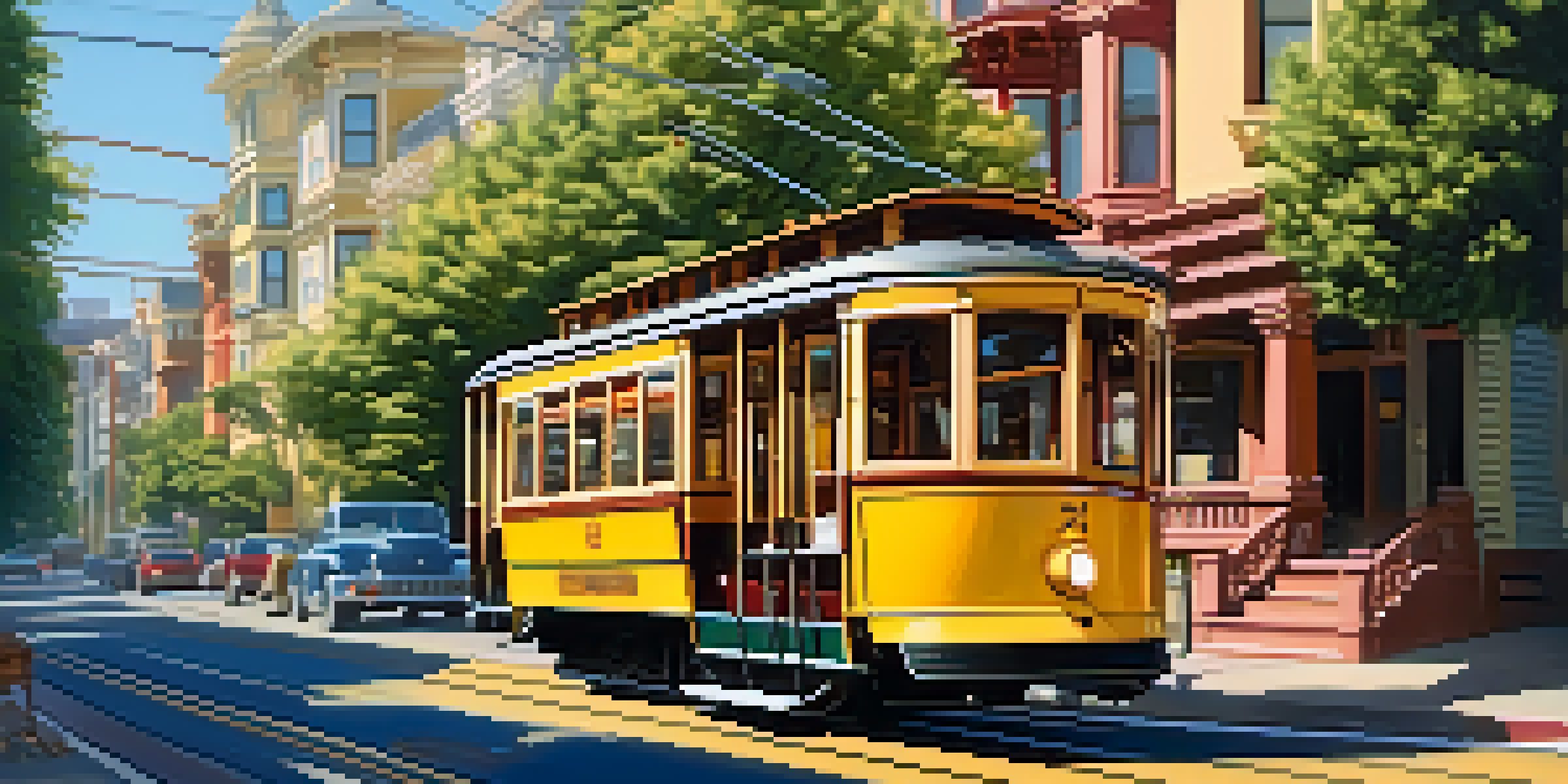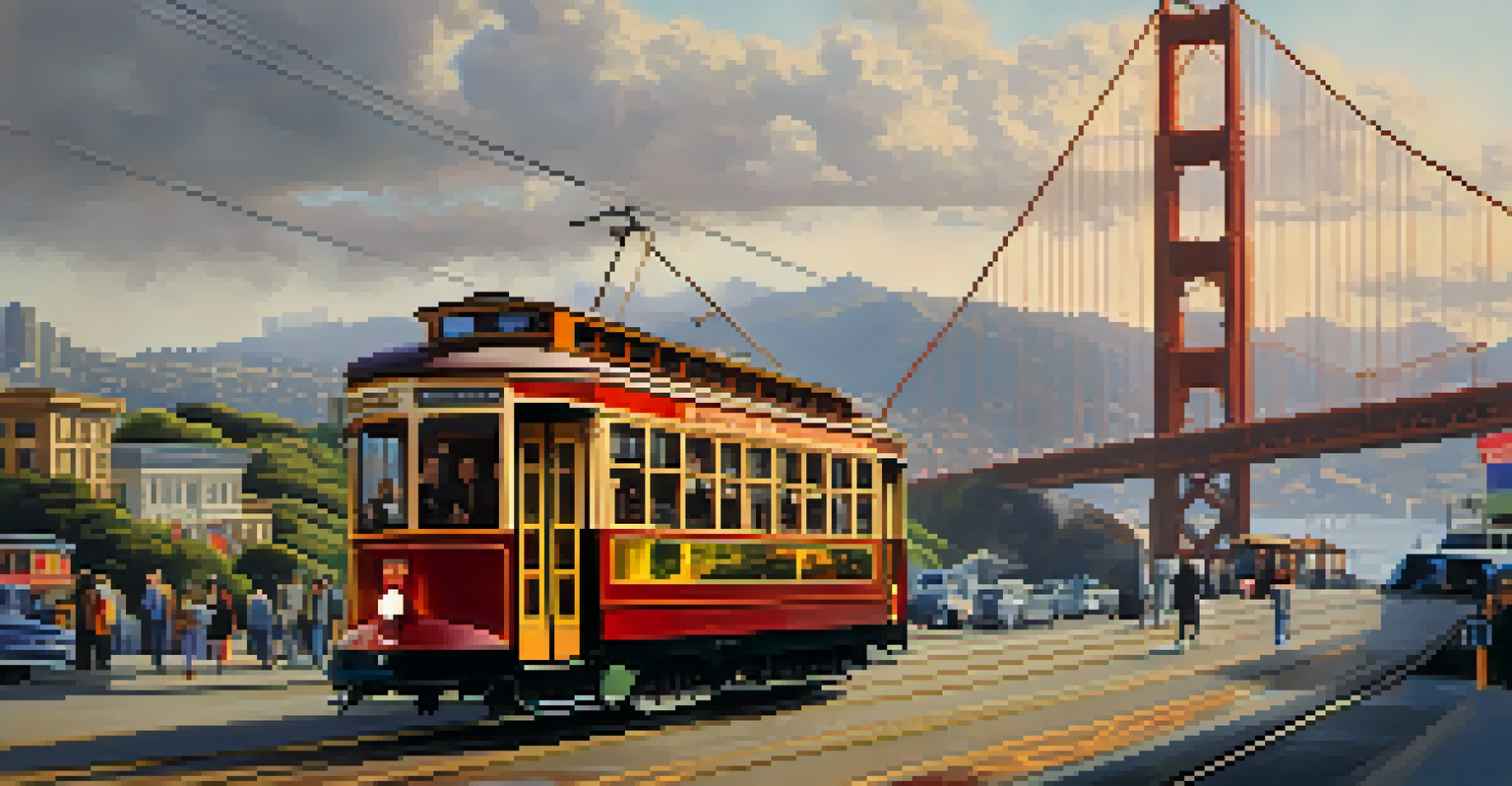The Evolution of San Francisco's Streetcar Systems Explained

The Birth of Streetcars in San Francisco
San Francisco's streetcar story began in the mid-19th century, when horse-drawn streetcars first made their appearance. These early vehicles provided a much-needed solution to the city’s steep hills and growing population. Imagine riding through the hilly streets, pulled by horses, as you enjoy the views of a bustling city.
Public transportation is a vital part of our urban landscape, connecting communities and making our cities more livable.
The introduction of rail tracks allowed for a more efficient transport system. By the 1870s, the city saw its first cable cars, which were revolutionary for their time. These cable cars, powered by underground cables, became a beloved symbol of San Francisco.
Streetcars quickly became the lifeline of the city, connecting neighborhoods and making travel more accessible. They transformed San Francisco into a more navigable urban space, laying the foundation for future developments in public transportation.
The Rise of Electric Streetcars in the Early 1900s
As technology advanced, the electric streetcar emerged, marking a new era in urban transport. The first electric streetcar line began operation in 1892, providing a faster and smoother ride compared to its horse-drawn predecessors. This innovation was akin to swapping a bicycle for a sports car—both get you to the same destination, but one is significantly quicker and more enjoyable.

Electric streetcars quickly gained popularity, leading to the expansion of the network throughout the city. With the ability to travel longer distances without the need for feeding and caring for horses, these streetcars became a staple for commuters. The convenience of this new transport option reshaped the daily lives of San Franciscans.
Streetcars: A Historical Journey
San Francisco's streetcar system evolved from horse-drawn vehicles in the 19th century to electric streetcars by the early 1900s, shaping urban transportation.
By the 1920s, the electric streetcar system had reached its peak, with lines stretching across the city. This extensive network not only facilitated transportation but also spurred economic growth by connecting neighborhoods and businesses like never before.
The Impact of the Great Depression on Streetcar Operations
The Great Depression brought significant challenges to the streetcar system, leading to reduced ridership and revenue. Many families struggled financially, and public transport saw a decline as people sought cheaper alternatives, such as walking or biking. This period felt like a heavy fog descending over the city, obscuring the once-vibrant streetcar lines.
The streetcar is a symbol of urbanity, a way to connect with the city and its inhabitants.
To cut costs, streetcar companies began to reduce services and even discontinue some lines. The impact on the community was profound, as many residents relied on streetcars for their daily commutes. This shift led to increased traffic congestion, as more people took to the roads, leading to a gradual decline in the appeal of public transport.
Despite these challenges, some streetcar systems managed to adapt and survive through innovative measures. They explored new operational strategies, such as integrating buses into their networks, which would eventually set the stage for the future of public transportation in San Francisco.
The Mid-Century Decline and Transition to Buses
The 1950s marked a turning point for San Francisco's streetcar systems as they faced increasing competition from buses and automobiles. The growing availability of personal vehicles changed the way people viewed public transport, and buses became the more popular choice for many. It was as if the charming streetcars were being overshadowed by the flashier, more modern vehicles.
As ridership dwindled, city officials began to phase out streetcar lines in favor of buses, which were seen as more cost-effective. This transition led to the dismantling of many historic streetcar routes, causing a sense of loss among the community. The once-bustling streetcar depots stood silent, a stark reminder of a bygone era.
Challenges and Resilience
The Great Depression and mid-century competition from buses led to the decline of streetcars, yet some systems adapted creatively to survive.
By the late 20th century, only a few streetcar lines remained operational, primarily serving tourist routes. However, the nostalgic appeal of streetcars lingered in the hearts of many, sparking conversations about their potential revival in the city.
The Revival of Streetcars in the Late 20th Century
The late 20th century saw a resurgence of interest in streetcars as cities began to recognize their value for urban transport. In San Francisco, this revival came in the form of the historic F-Line, which began operating in the late 1990s. It was a return to the roots, reminiscent of the city’s rich history and its enduring love for streetcars.
The F-Line not only celebrated the legacy of streetcars but also provided a functional link between neighborhoods and attractions. With vintage streetcars from around the world, the F-Line became a unique experience for both locals and tourists, blending history with modern transit needs. Riding the F-Line felt like taking a step back in time while still being part of the vibrant city life.
This revival sparked renewed discussions about expanding the streetcar network once again, blending modern technology with historical charm. The city began to explore how streetcars could alleviate traffic congestion and promote sustainable urban development.
Modern Innovations and Future Plans for Streetcars
As we move into the 21st century, San Francisco's transit authorities are exploring innovative ways to integrate streetcars into the modern urban landscape. The focus is on creating a more efficient and environmentally friendly transport system. Imagine a future where sleek, electric streetcars glide through the city, reducing reliance on fossil fuels and enhancing accessibility.
New proposals aim to expand the existing streetcar network, connecting underserved neighborhoods and making public transport more inclusive. Community input plays a crucial role in these plans, as residents voice their needs and preferences. This collaborative approach ensures that the future of streetcars aligns with the aspirations of the community.
Revival and Future Innovations
The late 20th century revival of streetcars, exemplified by the F-Line, highlights their cultural significance and potential for modern urban transport solutions.
By investing in modern streetcar technologies and infrastructure, San Francisco is poised to reclaim its status as a pioneering city in public transportation. The evolution of streetcars continues, promising to enhance the city’s charm while addressing contemporary transit challenges.
Streetcars: A Symbol of San Francisco's Unique Identity
Streetcars are more than just a mode of transport; they embody the spirit and character of San Francisco. Their rich history reflects the city’s resilience and adaptability in the face of change. Just like the iconic Golden Gate Bridge, streetcars have become a symbol of San Francisco’s unique identity.
The connection between streetcars and the city’s culture is evident in the way they bring people together. Whether it’s locals commuting to work or visitors exploring the vibrant neighborhoods, streetcars foster a sense of community and shared experience. Riding a streetcar can feel like being part of a living tapestry, weaving together diverse stories and backgrounds.

As the city continues to evolve, streetcars remain a crucial part of its narrative. They stand as a testament to San Francisco’s commitment to sustainable urban transport while celebrating its historical legacy. The future of streetcars in San Francisco looks promising, ensuring that this beloved mode of transport will continue to be an integral part of the city’s charm.